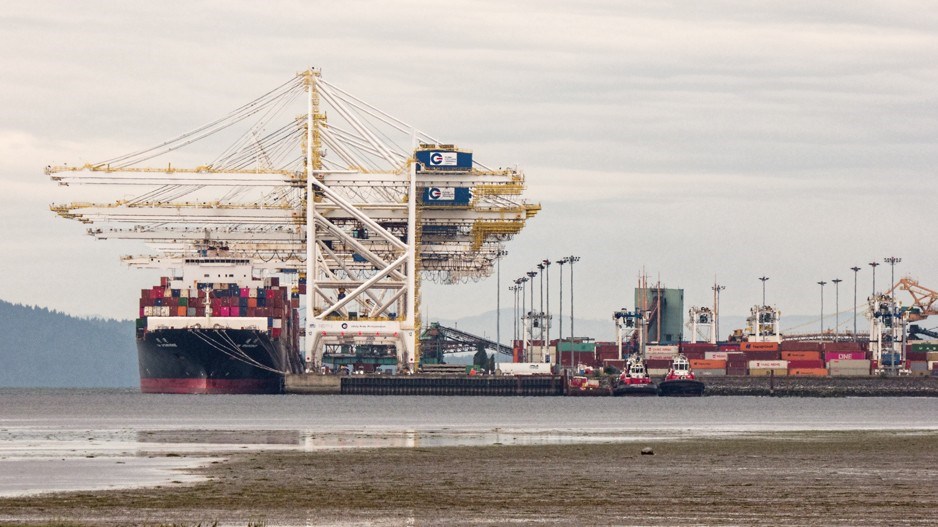The battle between the Vancouver Fraser Port Authority (VFPA) and one of its key container terminal tenants over the future of expanded Roberts Bank cargo handling capacity took centre stage in court earlier this month.
Federal judge George Pamel heard arguments from both sides during the October 18 to 21 hearing into GCT Global Container Terminals Canada Ltd.’s bid to quash a 2019 port authority decision to refuse to process its plan to expand GCT Deltaport. GCT is the operator/tenant at the VFPA’s Roberts Bank container terminal.
GCT has long contended that its smaller Deltaport Berth 4 expansion (DP4) is a less expensive and more market-driven project for the Port of Vancouver’s growing container cargo needs than VFPA’s plans to build Roberts Bank Terminal 2 (RBT2). The latter would require a large landfill that would essentially double the size of the landmass dedicated to container traffic at the mouth of the Fraser River Estuary in Tsawwassen.
Appearing before Pamel, GCT lawyers Peter Griffin, Matthew Lerner and Christopher Yung argued that the port authority’s “bias and closed mind” against DP4 in favour of its RBT2 project and its failure to properly assess DP4 demonstrate a failure in its duties as a regulator of the port’s facility developments.
Griffin said the only explanation for the VFPA’s March 1, 2019, notification to GCT that it would not process DP4’s preliminary project was port authority bias in favour of RBT2. That, Griffin said, is why GCT is asking Pamel to review the VFPA’s DP4 decision.
Among other things, GCT is seeking an official declaration that the VFPA “relied upon its own immediate commercial interest in the decision [on DP4] ... considerations incompatible with its role as a federal board, commission or other tribunal.”
The VFPA has stated that it wants another container terminal operator at Roberts Bank to ensure that there are port service options for ocean shipping lines and competition for container cargo handling.
GCT lawyers countered, however, by saying that there is no evidence that the port authority conducted any study or analysis of DP4 to support its decision to defer consideration of the project
“The evidence demonstrates that the VFPA concedes the conflict-of-interest inherent in its dual roles as proponent and regulator, and assures that it takes steps to have a ‘clear separation’ to address this inherent conflict – to make sure that those who work on the proponent side for RBT2 are not involved in the regulatory role in respect to DP4,” Lerner said.
“While admitting this separation is a minimum requirement, the evidence demonstrates that – in breach of its own standards of natural justice and procedural fairness – in fact, no such protections were implemented in regards to DP4 whatsoever.”
In their counter-arguments, VFPA lawyer Joan Young and Attorney General of Canada lawyer Sarah Bird said it is within the port authority’s mandate under the Canada Marine Act to choose what it considers to be the best approach to improving its ability to serve Canadian economic interests.
Young said the port authority was considering RBT2 in the early 2000s as the next step to expanding Roberts Bank’s container cargo-handling capacity. That was around the time the DP3 terminal, which is now operated by GCT, was completed.
Young and Bird also noted that RBT2 is about nine years into its regulatory process while DP4 is just beginning its environmental impact assessment.
“The port is not there to simply ensure the financial well-being of one particular tenant that wishes to do one particular thing,” Young said. “It has a very broad mandate with users all over the spectrum ... [it has] to look at the broad, big-picture needs ... of what is required for the successful, financially prudent operation of the port.”
She added that what GCT wants to do “is to become the port and make decisions on where and when port infrastructure is constructed and the timing of it. That is not their role ... And to the point that somebody is just going to build something, and we don’t have to worry about it, that’s a free-for-all approach to the management of the port. What if everyone turns their facilities into cruise ship terminals? That doesn’t meet Canada’s needs for trade facilitation.”
Pamel has yet to issue his decision as of press time (Oct.22).
The court battle comes as truckers, rail operators and other transport service providers lament an increasing container traffic backlog hitting Vancouver port facilities (see Cargo Congestion Surge Swamps Vancouver: BIV issue 1668; October 18-24) as transpacific supply chain congestion intensifies up and down North America’s West Coast.
As Bruce Rodgers, executive director of the Canadian International Freight Forwarders Association, previously pointed out to BIV, delays in approving major port expansion projects like either RBT2 or DP4, hamper the ability of the country’s supply chain to deal with the growth of transpacific and other trade.
As it stands, RBT2 is not slated to come online until the 2030s, even if Ottawa approves it.




